Thinking is the most fundamental of all human skills.
The quality of our future will depend directly on the quality of our thinking.
Is it then not only astonishing but also absurd that thinking is not the core subject in all education and the central subject on any school curriculum?
It is not.
It is not there at all.
There are some schools that teach thinking.
Many of them teach critical thinking, which is excellent but totally inadequate.
Judgement thinking is important but so is design thinking.
We need to create as well as to judge.
Management
 Management, Revised Edition
Management, Revised Edition
 Knowledge: Its Economics and Its Productivity
Knowledge: Its Economics and Its Productivity
 Innovation
Innovation
David Perkins at Harvard has shown that ninety per cent of errors in thinking are errors of perception.
This has also been my experience over the thirty years in which I have been involved in the teaching of thinking.
Yet over the ages we have put all the emphasis on logic.
If your perception is faulty, then even excellent logic will give you the wrong answer.
Excellent logic will not, itself, provide excellent perception.
More from Code-Book
If your eyesight is very sharp but you are looking in the wrong direction you will not see what you are looking ↓ for.
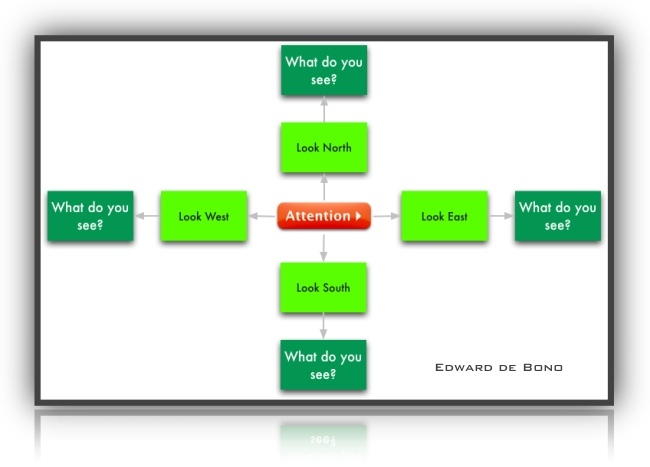
An explorer is sent to a newly discovered island.
The explorer returns and reports on a smoking volcano and a bird that does not fly.
The backers of the explorer are not satisfied:
‘What else was there?’
‘That is all that caught my attention,’ replies the explorer.
So the explorer is sent back again with some ‘attention-directing’ tools.
The explorer is asked to ‘look north and note what you see’.
Then, ‘look south and note what you see’.
Then look east and west in the same way.
Also make notes on:
flora, fauna, geology, water, etc., etc.
This becomes a sort of checklist — N,E,S, & W.
The seeing is directly related to perception
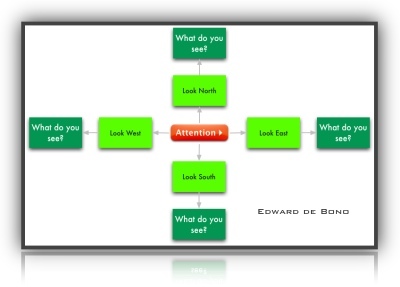
Writing out what you see
is different from saying it
mentally or verbally. It makes you decide.
Full size ↓
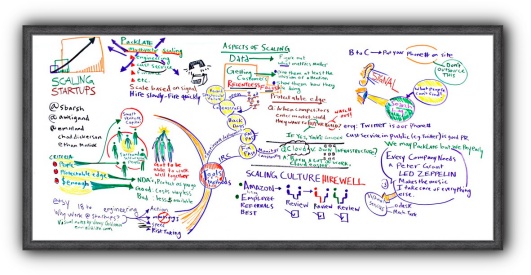
Attention-directing thought process in Teach Yourself To Think
Additionally, what are the implications of what you see?
Maybe this will help you SEE!
Dense reading and Dense listening ::: Thinking broad and Thinking detailed
Druckerisms — attention-directing thought jewels from PFD
The dimensions of the new realities are directions in which to look
Wisdom is largely about ‘broadening’ perception

“Managers are synthesizers
who bring resources together
and have that ability to “smell” opportunity and timing.
Today perceptiveness is more important than analysis.
In the new society of organizations,
you need to be able to recognize patterns
to see what is there
rather than what you expect to see.”
— Interview: Post-Capitalist Executive

We need 'attention-directing tools' for human perception. …
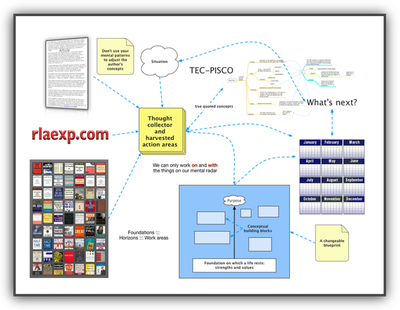
Larger view

Larger view
Each node offers opportunities for new perceptions
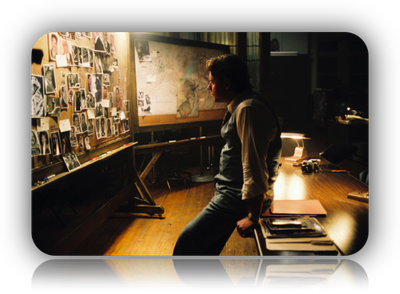
Other examples of attention-directing tools (N,E,S, & W):
 Readings in The Daily Drucker
Readings in The Daily Drucker
 From Analysis to Perception: The New World View in The New Realities and The Essential Drucker
From Analysis to Perception: The New World View in The New Realities and The Essential Drucker
 The Definitive Drucker
The Definitive Drucker
 Links at the bottom of this page
Links at the bottom of this page
 The image at the very top of this page
The image at the very top of this page
 Look for the long-term value in Drucker's writings
Look for the long-term value in Drucker's writings
… Many years ago I (Edward de Bono) designed a set of such tools.
They are now in use (as the CoRT programme) in thousands of schools around the world.
See Teach Your Child How to Think
They are also being taught in business through the DATT programme (operated by APTT).
In the Karee platinum mine in South Africa there used to be 210 fights every month between the seven different tribes working there.
After the basic attention-directing tools were taught (by Susan Mackie and Donalda Dawson) the fights dropped from 210 to just four.
Jennifer O'Sullivan, in Australia, had two job clubs and every one of her unemployed youngsters was deaf.
Teaching these youngsters CoRT thinking gave an employment rate more than double the average for job clubs.
In a pilot project with unemployed youngsters in the UK, the use of these methods by the Hoist Group improved unemployment four- to fivefold.

Attention-directing tools are very powerful.
If you are looking in the right direction you see things.
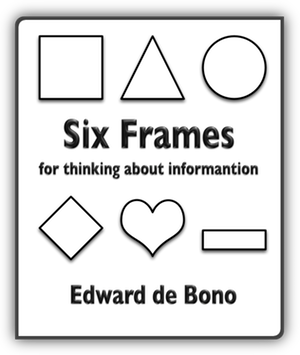
Six Frames For Thinking about Information
Conceptual resources
Attention-directing thought process in Teach Yourself To Think
Once you have seen something you cannot ‘unsee’ it.
Your thinking, choices, decisions are determined by what you have seen.
“Decision-making is a time machine that synchronizes into a single time — the present — a great number of divergent time spans” Chapter 11, Strategic Planning: The Entrepreneurial Skill, Management, Revised Edition by PFD

Different thoughts for different times
Jump to preparing to see then return
… to return use the back arrow on your browser

Click on the image below — it’s important
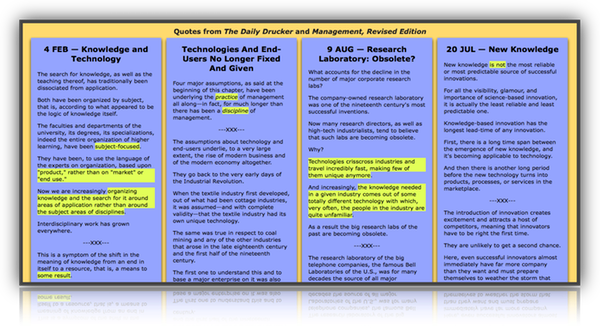
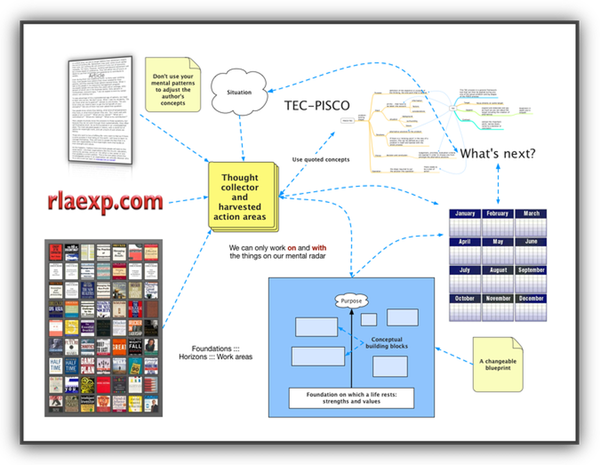

So Attention Directing Code 2 (In The De Bono Code Book) is a very simple set of attention-directing tools.
You can instruct yourself to use a particular tool.
You can ask someone else to use a particular tool.
You can suggest to a group that a particular tool be used.
- 2/1 Direct your attention to the PMI points. Tell me what you see.
PMI = Plus, Minus and Interesting.
Direct your attention to the Plus points,
then the Minus points
and finally the Interesting points.
The result is a quick assessment scan
-
2/2 Direct your attention to the future
-
2/3 What are the factors involved here?
-
2/4 What is the objective? What are we really trying to do?
-
2/5 What are the views of the other people involved?
-
2/6 What are the alternatives?
-
2/7 What are the priorities?
-
2/8 Direct your attention to the key values involved
-
2/9 Direct your attention to the matters on which we agree/disagree/irrelevant
-
2/10 Can you recognize this as a standard situation?

In a computer you might pull down a menu and then click on an item on that menu.
The thinking tools are items on a 'thinking menu'.
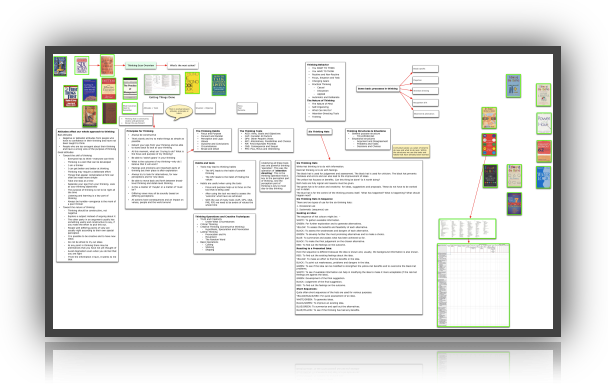
Larger view
Art is a choreography of attention.
You stand in front of a fine building.
It makes sense as a whole.
Find “whole” in The Daily Drucker
Find “whole” in Peter’s Principles
Then your attention flows to the pillars, the placement of the windows, perhaps the architrave, then back to one part of the whole, then to the detail of some scroll work.
This is a dance of attention.
Attention is perhaps the most fascinating aspect of the behaviour of perception.
As you stand in front of the building you feel you can direct attention to any part you like.
You can choose to look at the front door.
You can choose to look at the upper left hand corner.
You can choose to look at the proportions of the whole.
Such choosing reinforces the notion of 'I' and free-will
So there is attention flow and attention directing.
I want to look at attention directing first.
Walk into a room and looking fixedly ahead repeat to yourself: 'Chair, chair, chair.' Unless you consciously resist it, you will find your attention drawn to the chair in the room (if there is one) even though you are not looking at it.
This is an exactly parallel process to the self instruction to find red clothing at the sports meeting.
The instruction sensitizes certain circuits and so these patterns become active and we notice or pay attention to these things.
The attention-directing instructions may be even more simple.
See the explorer example above.
This is exactly the method we use for teaching thinking in schools with the CoRT programme.
In the section designed to improve breadth in perception we have a set of simple attention directing tools.
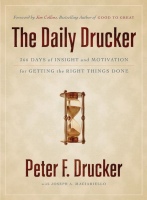
Connection: The Daily Drucker fits here as well.
For example there is the PMI.
This tool is used for deliberate scanning of the Plus, Minus and Interesting points, so that a thinker can properly evaluate a suggestion instead of just taking an initial emotional view and using thinking only to defend that view.
There is the C&S (Consequence and Sequel) for paying attention to the consequences of an action.
There is the OPV tool for paying attention to the other people involved and their view.
The tools are practised on a variety of different subjects so that skill is built up in the use of the tool which can then be transferred to real-life situations and is indeed so transferred.

Attention-directing thought process in Teach Yourself To Think
A person stands before a picture and says: 'I like it' or 'I don't like it.'
After a course on art appreciation that same person stands before a picture but now has a handful of attention directing tools:
… look at the composition;
… look at the choice of colours;
… look at the use of light and shade;
… look at the brush work;
… look at the way the clothing is treated;
… look at the background;
… look at the background figures.
After a time this richer attention scan becomes automatic.
In addition there are things that will now be noticed that may indicate a period of painting or a particular painter or a particular period of a particular painting (Picasso late period, Warhol early period).
“To know something,
to really understand something important,
one must look at it from sixteen different angles.
People are perceptually slow,
and there is no shortcut to understanding;
it takes a great deal of time.” — PFD
Beyond the Numbers Barrier

Six Frames For Thinking about Information
Attention-directing thought process in Teach Yourself To Think
We cannot see things unless we are prepared to see them.
That is why science advances by fits and starts as paradigms change and we are allowed to see things differently.
That is why the analysis of data can never produce all the ideas present in that data.
Think “big data” and information challenges.
The inherent weaknesses in all possible information systems
That is why analysis is a limited tool, not the complete one we have always believed it to be.
The James Gleick book on Chaos: Making a New Science shows how the pioneers in this field went back to look at old data but to look at it with new perceptions and could now see new things.
We come back now to sensitivities in the nerve network and the readiness to go active.
Contrast the directing of attention by specific self-instruction (look at the upper right-hand corner) with attention flow.
We look at a scene with a mind that has been sensitized by hunger.
Immediately our attention is drawn to the food.
We look at a scene with a mind sensitized to pick out certain patterns, so we notice them.
We look at a scene with a mind sensitized to pick up the slightest hint of insult or discrimination, so we immediately notice this (even if unintended).
Sometimes we use the word 'notice' when attention seems to flow to a particular area or when we pick something out.
In reality there is very little difference between directed attention and attention flow.
The directions sensitize our minds so attention flows into that area.
In the sports meeting example our instruction sensitizes the mind to notice red, so our attention flows to red clothing.
Underlying all this there is one key feature which I have not yet mentioned.
This is the 'unitary' nature of attention.
It is in the nature of a self-organizing patterning system (at least the one I have described) to have a single area of stabilization.
If there are two competing areas at any time, the large one will expand and the lesser one will disappear even if the difference is very slight.
This arises directly from the wiring of the system and is not an imposed condition.
It leads to one area of attention at a time.
It does not exclude the possibility that there are functionally different and parallel brains within our skulls.
![]()

![]()